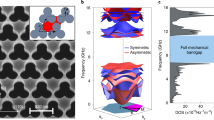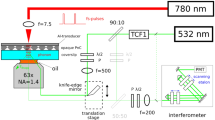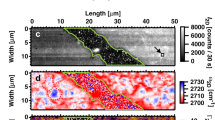Abstract
Shear phonons are collective atomic-layer motions in layered materials that carry critical information about mechanical, thermal and optoelectronic properties. Phonon branches with co-directional atomic-layer motions carry unique information about the global structure and hidden interfaces in layered crystals and heterostructures, but they are not detectable due to the very limited electron–phonon coupling. Here we utilize the propagating feature and mechanical coupling between shear phonons and localized plasmonic cavities to successfully realize direct characterization of ground-state shear phonons down to 4 cm−1 in energy by introducing mechano-Raman spectroscopy (MRS). MRS has the ability to characterize the global crystal structure with more than 108-fold enhancement and to accurately measure subpicometre displacements under ambient conditions with a thermal-noise-free feature. The propagating behaviour and the capacity of MRS to detect optically hidden interfaces are demonstrated. The broad tunability of plasmons makes the MRS technique a robust tool for extensive applications, including global crystal flaw detection, mechanical sensing and the mechanical modulation of light.
This is a preview of subscription content, access via your institution
Access options
Access Nature and 54 other Nature Portfolio journals
Get Nature+, our best-value online-access subscription
$29.99 / 30 days
cancel any time
Subscribe to this journal
Receive 12 print issues and online access
$209.00 per year
only $17.42 per issue
Buy this article
- Purchase on Springer Link
- Instant access to full article PDF
Prices may be subject to local taxes which are calculated during checkout




Similar content being viewed by others
Data availability
The datasets generated during and/or analysed during the current study are available from the corresponding author on reasonable request. Source data are provided with this paper.
References
Hunt, B. et al. Massive Dirac fermions and Hofstadter butterfly in a van der Waals heterostructure. Science 340, 1427–1430 (2013).
Xu, W. G. et al. Correlated fluorescence blinking in two-dimensional semiconductor heterostructures. Nature 541, 62–67 (2017).
Huang, B. et al. Layer-dependent ferromagnetism in a van der Waals crystal down to the monolayer limit. Nature 546, 270–273 (2017).
Cao, Y. et al. Unconventional superconductivity in magic-angle graphene superlattices. Nature 556, 43–50 (2018).
Burch, K. S., Mandrus, D. & Park, J. G. Magnetism in two-dimensional van der Waals materials. Nature 563, 47–52 (2018).
Tran, K. et al. Evidence for moire excitons in van der Waals heterostructures. Nature 567, 71–75 (2019).
Kim, S. E. et al. Extremely anisotropic van der Waals thermal conductors. Nature 597, 660–665 (2021).
Geim, A. K. & Grigorieva, I. V. Van der Waals heterostructures. Nature 499, 419–425 (2013).
Hong, X. P. et al. Ultrafast charge transfer in atomically thin MoS2/WS2 heterostructures. Nat. Nanotechnol. 9, 682–686 (2014).
Tan, P. H. et al. The shear mode of multilayer graphene. Nat. Mater. 11, 294–300 (2012).
Quan, J. M. et al. Phonon renormalization in reconstructed MoS2 moiré superlattices. Nat. Mater. 20, 1100–1105 (2021).
Zhang, K. et al. Enhancement of van der Waals interlayer coupling through polar Janus MoSSe. J. Am. Chem. Soc. 142, 17499–17507 (2020).
Luckyanova, M. N. et al. Coherent phonon heat conduction in superlattices. Science 338, 936–939 (2012).
Long, D. A. & Long, D. The Raman Effect: a Unified Treatment of the Theory of Raman Scattering by Molecules Vol. 8 (Wiley, 2002).
Madeo, J. et al. Directly visualizing the momentum-forbidden dark excitons and their dynamics in atomically thin semiconductors. Science 370, 1199–1203 (2020).
Wu, B. et al. Visible-light photoexcited electron dynamics of scandium endohedral metallofullerenes: the cage symmetry and substituent effects. J. Am. Chem. Soc. 137, 8769–8774 (2015).
Roelli, P., Galland, C., Piro, N. & Kippenberg, T. J. Molecular cavity optomechanics as a theory of plasmon-enhanced Raman scattering. Nat. Nanotechnol. 11, 164–169 (2016).
Chen, W., Roelli, P., Hu, H., Verlekar, S. & Galland, C. Continuous-wave frequency upconversion with a molecular optomechanical nanocavity. Science 374, 1264–1267 (2021).
Xomalis, A., Zheng, X., Chikkaraddy, R., Koczor-Benda, Z. & Baumberg, J. J. Detecting mid-infrared light by molecular frequency upconversion with dual-wavelength hybrid nanoantennas. Science 374, 1268–1271 (2021).
Benz, F. et al. Single-molecule optomechanics in ‘picocavities’. Science 354, 726–729 (2016).
Nie, S. & Emory, S. Probing single molecules and single nanoparticles by surface-enhanced Raman scattering. Science 275, 1102–1106 (1997).
Kneipp, K., Wang, Y., Kneipp, H., Perelman, L. T. & Feld, M. S. Single molecule detection using surface-enhanced Raman scattering (SERS). Phys. Rev. Lett. 78, 1667–1670 (1997).
Li, J. F. et al. Shell-isolated nanoparticle-enhanced Raman spectroscopy. Nature 464, 392–395 (2010).
Zhang, R., Dong, Y., Jiang, Z. C. & Chen, S. C. Chemical mapping of a single molecule by plasmon-enhanced Raman scattering. Nature 498, 82–86 (2013).
Joonhee et al. Visualizing vibrational normal modes of a single molecule with atomically confined light. Nature 568, 78–92 (2019).
Xu, J. Y. et al. Determining structural and chemical heterogeneities of surface species at the single-bond limit. Science 371, 818–822 (2021).
Ding, S. Y., Yi, J., Li, J. F., Ren, B. & Tian, Z. Q. Nanostructure-based plasmon-enhanced Raman spectroscopy for surface analysis of materials. Nat. Rev. Mater. 1, 16021 (2016).
Gonzalez-Rubio, G. et al. Femtosecond laser reshaping yields gold nanorods with ultranarrow surface plasmon resonances. Science 358, 640–644 (2017).
Duan, S., Rinkevicius, Z., Tian, G. J. & Luo, Y. Optomagnetic effect induced by magnetized nanocavity plasmon. J. Am. Chem. Soc. 141, 13795–13798 (2019).
Sharma, B., Frontiera, R. R., Henry, A. I., Ringe, E. & Van Duyne, R. P. SERS: materials, applications and the future. Mater. Today 15, 16–25 (2012).
Butt, H. J. & Jaschke, M. Calculation of thermal noise in atomic-force microscopy. Nanotechnology 6, 1–7 (1995).
Cong, C. X. & Yu, T. Enhanced ultra-low-frequency interlayer shear modes in folded graphene layers. Nat. Commun. 5, 4709 (2014).
Meyer, J. C. et al. On the roughness of single- and bi-layer graphene membranes. Solid State Commun. 143, 101–109 (2007).
Wang, G. R. et al. Bending of multilayer van der Waals materials. Phys. Rev. Lett. 123, 116101 (2019).
Meyer, J. C. et al. The structure of suspended graphene sheets. Nature 446, 60–63 (2007).
Salvetat, J. P. et al. Elastic and shear moduli of single-walled carbon nanotube ropes. Phys. Rev. Lett. 82, 944–947 (1999).
van Baren, J. et al. Stacking-dependent interlayer phonons in 3R and 2H MoS2. 2D Mater. 6, 025022 (2019).
Lee, C., Wei, X. D., Kysar, J. W. & Hone, J. Measurement of the elastic properties and intrinsic strength of monolayer graphene. Science 321, 385–388 (2008).
Riedinger, R. et al. Non-classical correlations between single photons and phonons from a mechanical oscillator. Nature 530, 313–316 (2016).
Yu, H. Y., Liu, G. B., Tang, J. J., Xu, X. D. & Yao, W. Moiré excitons: from programmable quantum emitter arrays to spin-orbit-coupled artificial lattices. Sci. Adv. 3, e1701696 (2017).
Novoselov, K. S. et al. Two-dimensional atomic crystals. Proc. Natl Acad. Sci. USA 102, 10451–10453 (2005).
Xu, W. G. et al. Graphene-veiled gold substrate for surface-enhanced Raman spectroscopy. Adv. Mater. 25, 928–933 (2013).
Acknowledgements
This work was supported by the National Natural Science Foundation of China (22173044, 21873048 and 22073017), the Natural Science Foundation of Jiangsu Province (BK20220121), the National Key R&D Program of China (2020YFA0406104), the Fundamental Research Funds for the Central Universities in China (021014380177), the Frontiers Science Center for Critical Earth Material Cycling of Nanjing University (DLTD2110), ‘Innovation & Entrepreneurship Talents Plan’ of Jiangsu Province and the Innovation Program for Quantum Science and Technology (2021ZD0303301, 2021ZD0303303 and 2021ZD0303305). Z.J. acknowledges funding support from the CAS Interdisciplinary Innovation Team and the National Natural Science Foundation of China (12074371).
Author information
Authors and Affiliations
Contributions
W.X. and S.F. conceived the initial idea. W.X., Y.L., S.D. and S.F. designed the experiments. S.F. fabricated the samples and performed the spectroscopy measurement experiments with help from L.L., H.L., B.J., C.L., N.W. and L.Z., and Y.Y., S.C. and X. Wen performed finite-difference time-domain simulations. S.D., J.Z., X. Wang, D.X., Y.L. and W.X. contributed to theoretical analyses. S.F. collected and organized all experimental data. S.F., S.D., X. Wang, H.L., Y.L. and W.X. co-wrote the manuscript, with input from all authors.
Corresponding authors
Ethics declarations
Competing interests
The authors declare no competing interests.
Peer review
Peer review information
Nature Photonics thanks the anonymous reviewers for their contribution to the peer review of this work.
Additional information
Publisher’s note Springer Nature remains neutral with regard to jurisdictional claims in published maps and institutional affiliations.
Supplementary information
Supplementary Information
Supplementary text, Figs. 1–12, Tables 1 and 2, references and caption for Video 1.
Supplementary Video 1
Schematic view of a 1,000,000,000,000 times slow motion of MRS processes driven by ν1 and ν12 shear phonon vibrators in 13LG.
Source data
Source Data Fig. 1
Source data.
Source Data Fig. 2
Source data.
Source Data Fig. 3
Source data.
Source Data Fig. 4
Source data.
Rights and permissions
Springer Nature or its licensor (e.g. a society or other partner) holds exclusive rights to this article under a publishing agreement with the author(s) or other rightsholder(s); author self-archiving of the accepted manuscript version of this article is solely governed by the terms of such publishing agreement and applicable law.
About this article
Cite this article
Fang, S., Duan, S., Wang, X. et al. Direct characterization of shear phonons in layered materials by mechano-Raman spectroscopy. Nat. Photon. 17, 531–537 (2023). https://doi.org/10.1038/s41566-023-01181-5
Received:
Accepted:
Published:
Issue Date:
DOI: https://doi.org/10.1038/s41566-023-01181-5



